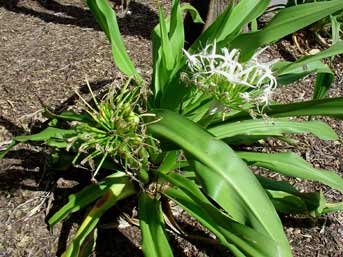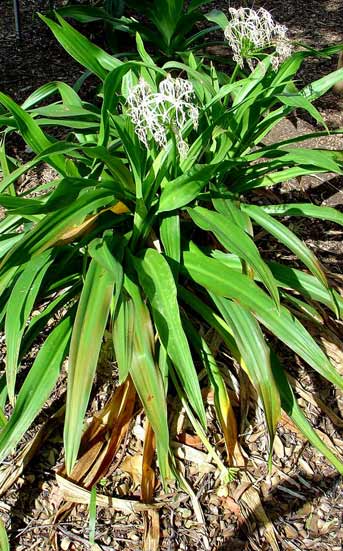Uses: The white flowered kieb, which was probably introduced from Asia in more recent times, is planted in rows and now acts as boundary markers signifying land ownership. In addition to the plant's use as a visual ornamental, cut flowers impart a pleasant aroma to people's homes and provide party decorations. The red flowered kieb, which probably arrived in the Marshall Islands before European contact, grows near houses and along roadsides. Cut pieces mixed with copra are fed to pigs and chickens. Kieb also has a variety of medicinal uses. |
Description: This species in the amaryllis family is referred to in English as the "spider lily" because of the shape its flowers. Kieb produces a rosette of 6 to 30 long, narrow, stemless evergreen leaves. A thick, more or less flattened flower stalk grows out of the center of the rosette of leaves to heights of about 60 cm (2 ft). The flowers consist of a narrow, straight or curved, white to reddish tube, from which six long petals spread widely or in a funnel shape. |

A Recipe : Kieb is used to treat boils in the following manner: "Put the leaf on a fire to heat it up, then put coconut oil on it, then put it on the boil. Leave for 4-5 hours, then the boil will be gone." Medical practitioners utilize the main branch of kieb in the treatment of broken bones. It is placed on wounds to stop bleeding. The young stalks may be pounded and applied as a poultice to an internally injured knee. The inner shoots of a thick stalked variety is an ingredient of a medicine for babies.
|
Distribution: According to the botanist Fosberg, Crinum bakeri is known only from the Marshall Islands. While it was probably brought to the Marshall Islands by the Marshallese, possibly it is a plant variety obtained through cultivation (a cultivar) of Crinum asiaticum.

|

